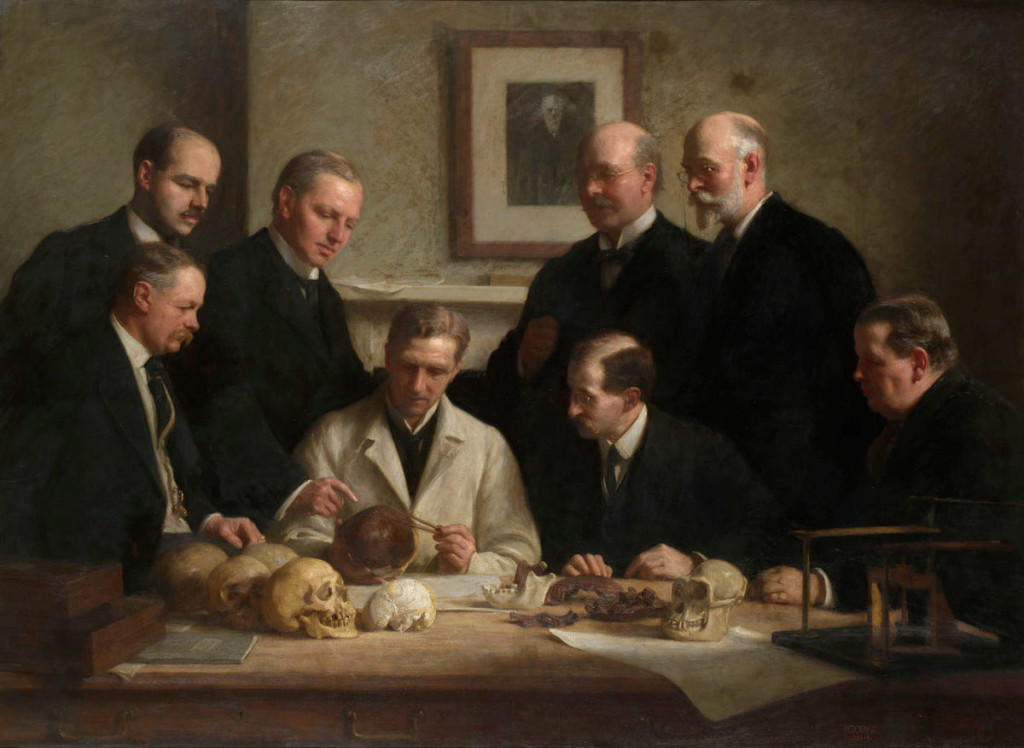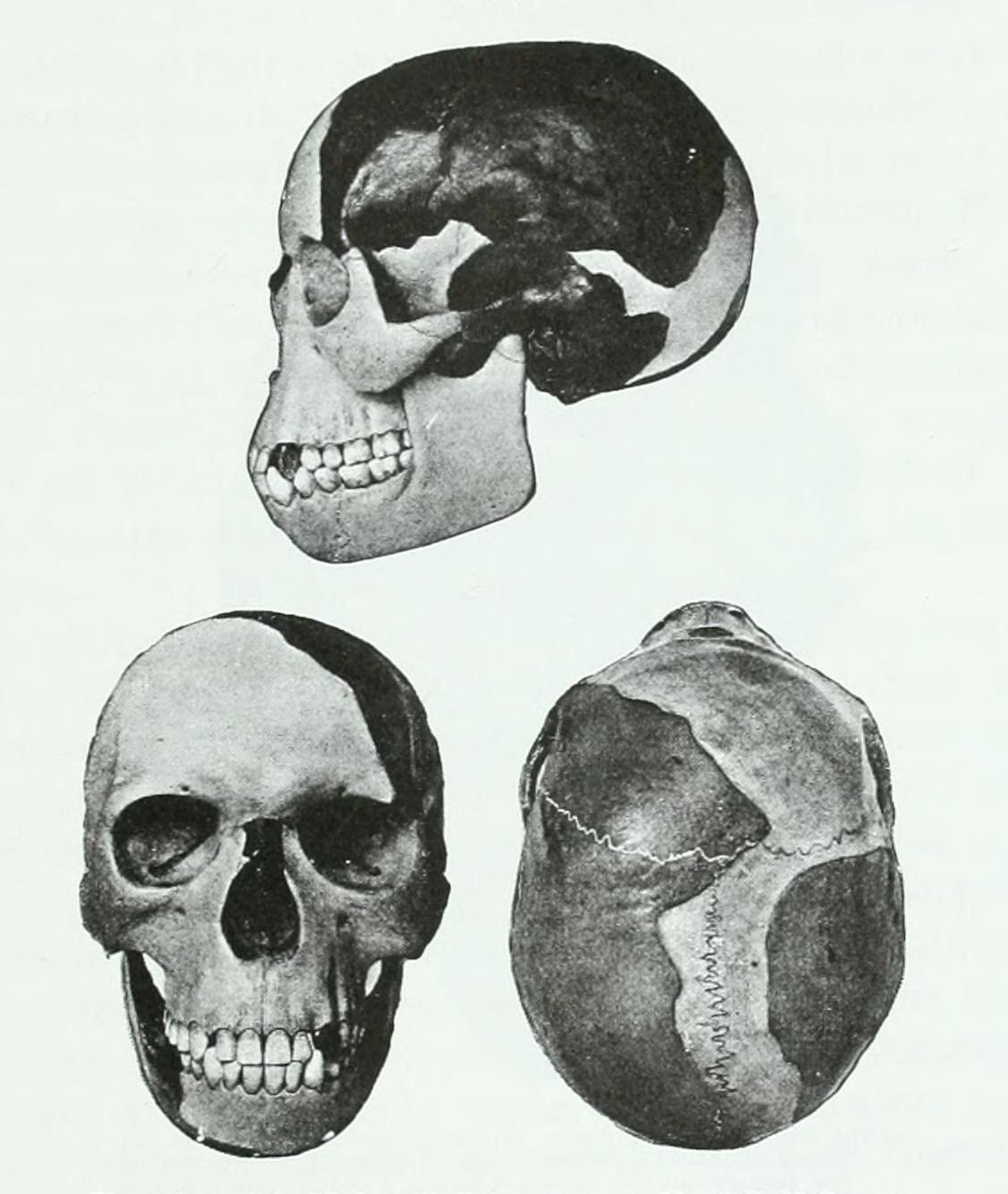
Group portrait of the Piltdown skull being examined. Back row (from left): F. O. Barlow, G. Elliot Smith, Charles Dawson, Arthur Smith Woodward. Front row: A S Underwood, Arthur Keith, W. P. Pycraft, and Ray Lankester. Painting by John Cooke, 1915
On December 18, 1912, the discovery of the skull known as Piltdown man, the first important fossil human skull ever to be unearthed in England was announced at a meeting of the Geological Society of Great Britain. The specimen occupied an honored place in the catalogues of fossil hominids for the next 40 years. But in 1953, thanks to some rigorous scholarly detective work, Piltdown man was revealed to be nothing more than a forgery, manufactured from modern human and animal remains.
How it all started…
British amateur archaeologist Charles Dawson claimed at a meeting of the Geological Society of London that a workman at the Piltdown gravel pit had given him a fragment of the skull four years earlier. He explained that the workers discovered the skull shortly before his visit and broke it up in the belief that it was a fossilised coconut. Dawson claimed to have visited the site again and took further fragments to Arthur Smith Woodward, keeper of the geological department at the British Museum, who was highly interested in the findings and both continued working on the project until September 1912. In the meantime, Dawson found several further skull fragments as well as half of a jaw bone by himself.
The Meeting at the Geological Society
At the said meeting, Woodward described the findings to be similar to the skull of a modern human except for the occiput, the part that sits on the spinal column. He further explained that the brain size was approximately two-thirds that of a modern human and proposed the famous Piltdown Man to be an evolutionary missing link between apes and humans. However, Woodward’s reconstruction of the Piltdown fragments was strongly challenged by some researchers almost immediately. At the Royal College of Surgeons, copies of the same fragments used by the British Museum in their reconstruction were used to produce an entirely different model, one that in brain size and other features resembled a modern human.
The Tooth Discussion
French philosopher and Jesuit priest who trained as a paleontologist and geologist Pierre Teilhard de Chardin joined the discussion and began a systematic search of the spoil heaps specifically to find the missing canines. He was able to find a canine that, according to Woodward, fitted the jaw perfectly. Woodward probably expected the find to end any dispute over his reconstruction of the skull. However, Arthur Keith argued that human molars are the result of side to side movement when chewing. The canine in the Piltdown jaw was impossible as it prevented side to side movement. To explain the wear on the molar teeth, the canine could not have been any higher than the molars. After years of discussion, Franz Weidenreich examined the remains and correctly reported that they consisted of a modern human cranium and an orangutan jaw with filed-down teeth. In 1915, Dawson claimed to have found fragments of a second skull at a location about two miles from the location of the original finds. After Dawson’s death the following year, the site in question (Piltdown II) could no longer be precisely identified, and the finds are poorly documented.

Three Views of the Piltdown Skull: 1915 Reconstruction by James Howard McGregor
How to create a Forgery
In 1953, Time magazine published evidence gathered variously by Kenneth Page Oakley, Sir Wilfrid Edward Le Gros Clark and Joseph Weiner proving that the Piltdown Man was a forgery. It was demonstrated that the fossil was a composite of three distinct species. It consisted of a human skull of medieval age, the 500-year-old lower jaw of an orangutan and chimpanzee fossil teeth. Someone had created the appearance of age by staining the bones with an iron solution and chromic acid. Microscopic examination revealed file-marks on the teeth, and it was deduced from this that someone had modified the teeth to a shape more suited to a human diet.
To this day, the real identity of the Piltdown forger is unknown. However, several scientists including Dawson and Pierre Teilhard de Chardin have been named as suspects. The focus on Charles Dawson as the main forger is supported by the accumulation of evidence regarding other archaeological hoaxes he perpetrated in the decade or two prior to the Piltdown discovery. Archaeologist Miles Russell of Bournemouth University analyzed Dawson’s antiquarian collection, and determined that at least 38 of his specimens were fakes.
How to fool the Scientific Community
At the time of the Piltdown finds only a few remains of early humans had been found; among the best known were the Neanderthal near Düsseldorf (the fossil Neanderthal 1, 1856,[4]), the Java man (1891), the lower jaw of Mauer (1907) and the Neanderthal find La Chapelle-aux-Saints 1 from France. The scientists mostly interpreted the finds as transitional forms to modern man, however, the sparse finds still allowed a multitude of interpretations, so also in the question in which order the development steps on the way to modern man took place. The discovery of Piltdown seemed to answer this question once and for all and was therefore a sensational discovery. This probably explains its quick acceptance, although the circumstances of the discovery were already dubious. German and French researchers, on the other hand, had doubts about the significance of the Piltdown fragments right from the start due to their precise knowledge of the Neanderthal finds. Even in the light of later fossil finds from Asia and Africa, the Piltdown man was at best able to assert himself as a puzzling minor branch in the human family tree, since they took a completely different path to modern man, younger overall and with a late onset increase in brain volume.
Pop Legacy
However, there are references of the Piltdown Man even in pop culture. The early short story Dagon by H. P. Lovecraft, written in 1917, already refers to the Piltdown man. Also in the later short story The Rats in the Wall Lovecraft mentions him. In “The Psychiatrist,” an episode of the 1979 Fawlty Towers, a lower-class guest is referred to as “Piltdown pansy”. In March 1994, Apple Computer introduced the Power Macintosh 6100, code-named Piltdown Man.
Great Myths and Legends: The Piltdown Fossil Forgery and the Search for the “First Englishman”, [9]
References and Further Reading:
- [1] Natural History Museum: “Piltdown Man—the greatest hoax in the history of science?”
- [2] BBC History: Piltdown Man: Britain’s Greatest Hoax
- [3] The Piltdown Man at History.com
- [4] The Discovery of the Neanderthal Man, SciHi Blog
- [5] Dr. Jane Monge, Great Myths and Legends: The Piltdown Fossil Forgery and the Search for the “First Englishman”, PennMuseum, You Tube
- [6] Piltdown Man hoax centenary event held at BBC News 22. September 2012
- [7] The Piltdown Man Discovery. Unveiling of a Monolith Memorial. In: Nature. vol 142, 30. July 1938, p. 196.
- [8] The Piltdown Man at Wikidata
- [9] Great Myths and Legends: The Piltdown Fossil Forgery and the Search for the “First Englishman”, Penn Museum @ youtube
- [10] Spencer, Frank (1990). The Piltdown papers, 1908–1955: the correspondence and other documents relating to the Piltdown forgery. Natural History Museum Publications.
- [11] Woodward, A. Smith (1913). “Note on the Piltdown Man (Eoanthropus Dawsoni)”. The Geological Magazine. 10 (10): 433–34
- [12] Walsh, John E. (1996). Unraveling Piltdown: The Science Fraud of the Century and its Solution. Random House.
- [13] Blinderman, Charles (1986), The Piltdown Inquest, Buffalo, NY: Prometheus Books
- [14] De Groote, Isabelle (10 August 2016). “Solving the Piltdown Man crime: how we worked out there was only one forger”. The Conversation. United States: The Conversation.
- [15] Map with archaeological forgeries, via DBpedia and Wikidata





